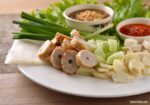Mango sticky rice, or “Khao Niew Mamuang” in Thai, is a beloved dessert that embodies the essence of Thai cuisine. This delectable treat is a harmonious blend of glutinous rice, ripe mango, and creamy coconut milk, resulting in a symphony of flavors and textures that captivate both locals and visitors alike.
Originating in Thailand, mango sticky rice is a seasonal dessert, typically enjoyed during the hot season when mangoes are at their ripest and most flavorful. This dish has a deep cultural significance and is often associated with the Thai New Year, Songkran, when families gather to celebrate and share festive foods.
The preparation of mango sticky rice begins with the selection of the main ingredient: the glutinous or sticky rice. Unlike regular rice, glutinous rice is known for its sticky and chewy texture, which is essential for achieving the desired consistency of the dish. The rice is soaked for several hours or overnight, then steamed until it becomes tender and sticky.
The coconut milk sauce, an integral component of mango sticky rice, is prepared by simmering fresh coconut milk with sugar and a pinch of salt. This sauce is then poured over the cooked sticky rice, allowing it to absorb the rich, creamy flavors. The combination of sweet and slightly salty coconut milk enhances the natural sweetness of the mango, creating a perfectly balanced dessert.
Selecting the right mango is crucial for the authenticity of this dish. The preferred variety is the Nam Dok Mai mango, known for its fragrant aroma, smooth texture, and sweet, juicy flesh. The mango is peeled and sliced into thick, luscious pieces, which are then artfully arranged alongside the sticky rice.
Presentation is an important aspect of mango sticky rice. The dish is often served on a banana leaf, adding an extra layer of fragrance and tradition. The vibrant yellow mango contrasts beautifully with the white sticky rice, creating an inviting and visually appealing dessert. A final drizzle of coconut milk and a sprinkling of toasted sesame seeds or mung beans add a delightful crunch and extra depth of flavor.
Mango sticky rice is more than just a dessert; it is a cultural experience. Each bite offers a glimpse into Thai culinary traditions, showcasing the harmonious balance of flavors that defines Thai cuisine. The creamy coconut milk, sweet mango, and chewy sticky rice come together in a delightful dance that leaves a lasting impression on the palate.
In Thailand, mango sticky rice is enjoyed throughout the day, whether as a dessert, a snack, or even a light meal. It is commonly found in street markets, restaurants, and homes, each version offering a slightly different take on the classic recipe. Street vendors often sell it in small, portable portions, making it an accessible treat for both locals and tourists exploring the bustling markets of Bangkok or the serene beaches of Phuket.
The popularity of mango sticky rice has transcended Thai borders, making its way to international menus and gaining a following among food enthusiasts worldwide. Its simple yet exquisite combination of ingredients has earned it a place in the hearts of many, who seek to recreate the authentic Thai experience in their own kitchens.
The enduring appeal of mango sticky rice lies in its simplicity and the quality of its ingredients. Fresh, ripe mangoes and high-quality coconut milk are essential for achieving the authentic taste that defines this beloved dessert. The careful preparation and attention to detail reflect the Thai philosophy of balance and harmony in food, where every ingredient plays a vital role in creating a cohesive and delightful dish.
For those who have had the pleasure of tasting mango sticky rice in Thailand, the memory of its sweet, creamy flavor lingers long after the last bite. It is a dish that evokes the warmth and hospitality of Thai culture, a sweet reminder of the beauty and richness of Thai culinary traditions. Whether enjoyed in a bustling market, a fine dining restaurant, or a cozy home kitchen, mango sticky rice remains a timeless and cherished treat that continues to captivate taste buds and hearts around the world.





